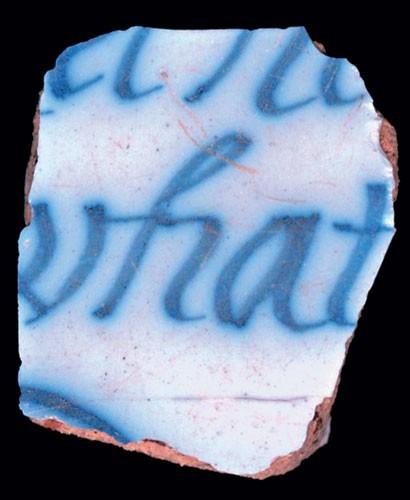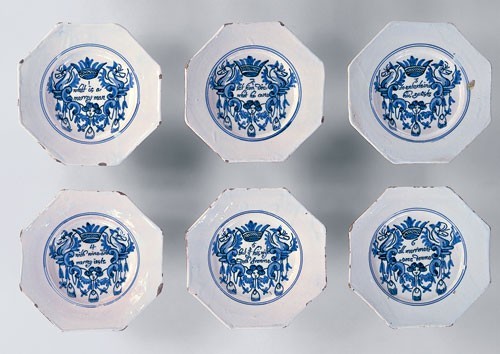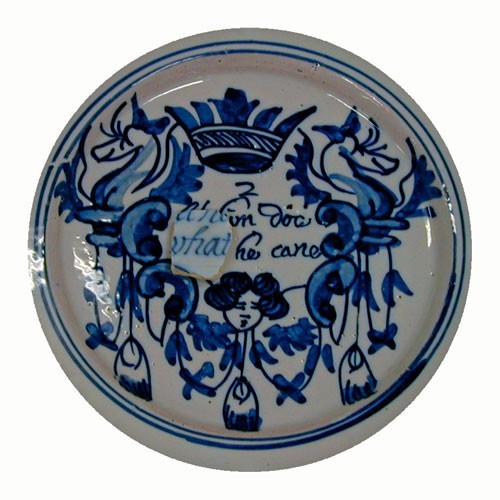
Plate sherd, English, 1680– 1700. Tin-glazed earthenware. H. 7/8". Hand-painted in cobalt blue “... what ....” (Courtesy, Historic St. Mary’s City.)

Set of six octagonal plates, probably Dutch, possibly British, ca. 1684. Tin-glazed earthenware. D. 8 1/8". (Courtesy, Historic Deerfield.)

Merryman plate, English, 1680–1700. Tin-glazed earthenware. D. 8 1/2"(Courtesy, Historic Deerfield; photo, Silas Hurry.) The sherd illustrated in fig. 1 has been superimposed on a portion of the Merryman verse, “Let him doe what he cane,” the central motif for this plate.
Archaeological excavations at the Print House site in St. Mary’s City, Maryland, during the summer of 2003 uncovered a fragment of tin-glazed earthenware decorated in blue. A plate sherd, it bears the word what below a fragmentary line of script (fig. 1). A little research quickly identified the word as part of the inscription on the so-called Merryman plate series.[1] More information is available about the Print House than why a Merryman plate was uncovered at this location.
St. Mary’s City was the capital of Maryland from the founding of the colony in 1634 until 1695, when it was replaced by Annapolis. Maryland, the third permanent English colony established along the Atlantic coast, was the first to be a proprietary colony—that is, a colony owned by a private individual rather than the crown or a joint stock company. The colony was in the possession of the Calvert family, Roman Catholic Englishmen from a time when Roman Catholicism was virtually banned in Great Britain. In 1689 the Calvert regime was overthrown by a group known as the Protestant Associators in an event that was an American expression of England’s Glorious Revolution.
After the 1695 move of the capital to Annapolis, St. Mary’s City was all but abandoned, and slowly the aboveground signs of its seventeenth-century existence disappeared. In the 1960s the state of Maryland began acquiring the land where the city had stood to create an outdoor museum. Since the 1970s archaeology has been an essential element in the development of the museum.
As part of the mission to preserve, protect, and interpret this important site of human endeavor, Historic St. Mary’s has been systematically investigating a variety of seventeenth-century archaeological sites. One that has been the focus of work for the past several years is a site related to printing. St. Mary’s City had the first printing establishment south of Boston in English North America. The press was operated by William Nuthead and his wife, Dinah. Among the documents known to have been printed by Nuthead in St. Mary’s City was The Declaration of the Reasons and Motives for the Present Appearing in Arms of Their Majesties Protestant Subjects in the Province of Maryland, which outlined the rebels’ position for their overthrow of the Calvert regime.
After her husband died, Dinah moved the press to Annapolis, where she continued to print forms and bills for the government of Maryland. Historic records indicate that Dinah “signed” documents with a mark, suggesting she could not write but apparently could print. The fact that a plate decorated with verse was recovered at the site where a printing press operated appears to be totally fortuitous and may relate to either earlier or later uses of the structure.
Beginning about 1680 and continuing through the eighteenth century, sets of six tin-glazed earthenware plates, known to collectors as “Merryman” plates, were popular in England. All the plates in a set apparently were decorated in blue and each contains a line from the same basic verse:
What is a Merryman
Let him do what he can
To entertain his guests
With wine and merry jest
But if his wife do frown
All merriment goes down
Although often seen with creative spellings and occasional paraphrases, the Merryman verse is one of the most popular text-based decorations on tin-glazed earthenware.[2] The verse appears on examples dated as early as 1682. After a period of popularity in the 1680s and 1690s, the verse is less common from the 1720s until the 1740s, when it stages a comeback. The early Merryman plates are decorated with a Mannerist arabesque motif incorporating griffins, a crown, a cherub face, and scrolls; the later style uses a simple wreath or garland design. The earliest dated example with an arabesque motif is from 1682, the latest from 1704; the earliest wreath or garland motif dates to 1716, the latest to 1752.[3] Examples from the early period are sometimes octagonal in shape (fig. 2), but circular forms seem to be the most common for both periods.
Merryman plates served both as decoration and as utilitarian dining pieces. All were numbered to ensure that the poem was read in the proper order. The sentiment reflects a theme of hospitality common to the period and the restraint from overindulgence created by the tempering influence of a female presence. A search in published nursery rhymes and early verse has failed to discover a literary source for the poem. A play on words of the similar sounding “merry” and “marry” has been suggested—to be exact, that a “married man” may not be a “merryman.”[4] The longevity of the design may speak to the rise in “genteel” social behaviors that came to dominate colonial American culture in the eighteenth century, as the verses served as gentle reminders to be genteel.[5]
Decorated with an arabesque motif, the sherd from the Print House site at St. Mary’s City may be the first Merryman plate recovered by archaeologists in North America. Examples have been discovered in England and in Delft.[6] Wreath-motif plates with other verses have been found at pottery production sites in the United Kingdom. It has been suggested that the earliest Merryman plates were produced in Holland for the English market, possibly inspiring some of the creative spellings.[7]
In the late fall of 2003 I had the opportunity to handle a set of Merryman plates at Historic Deerfield and to discuss the subject with curator Amanda Lange. She graciously allowed me to place the single St. Mary’s sherd on a complete plate in their collections to match the decorations. Although the scale of the Deerfield plate was a little smaller, the match was quite convincing (fig. 3).
An entire year of excavation and artifact processing has passed since the single Merryman plate sherd emerged from the excavations. Comprehensive excavations have uncovered architectural evidence for the structure that stood on the Print House site in the late seventeenth century, and Historic St. Mary’s City is currently preparing to reconstruct the building for the interpretation of printing in early Maryland. In spite of the intensive efforts in both the field and the laboratory, no additional sherds of the plate, or any of its mates, have come to light.
ACKNOWLEDGMENTS
I wish to thank the archaeologists and staff of Historic St. Mary’s City whose excavation and study made this article possible; my many colleagues in the United States, Canada, England, and Holland who have patiently answered my many emailed inquiries; and, most especially, Amanda Lange and Jessica Neuwirth of Historic Deerfield, who arranged for me to see the complete examples in their collection. Thanks also to Robert Hunter, who proposed that I write this piece and assured me I was not out of my mind when I first suggested that we had found a fragment of a Merryman plate.
Silas D. Hurry, Curator of Collections, Historic St. Mary’s City; sdhurry@ smcm.edu
Louis Lipski and Michael Archer, Dated English Delftware, Tin Glazed Earthenware, 1600–1800 (London: Sotheby Publications, 1984), pp. 52–126.
Cary Carson, “The Consumer Revolution in Colonial America: Why Demand?” in Of Consuming Interest: The Style of Life in the Eighteenth Century, edited by Cary Carson, Ronald HoVman, and Peter J. Albert (Charlottesville: University Press of Virginia for the United States Capital Historical Society, 1994), p. 604.
Lipski and Archer, Dated English Delftware, pp. 52, 53, 67, 75, and 604.
Amanda E. Lange, Delftware at Historic Deerfield, 1600–1800 (Deerfield, Mass.: Historic Deerfield, Inc., 2001), p. 111.
Carson, “Consumer Revolution,” p. 605.
The English example, which depicts a wreath motif, is illustrated in J. P. Allan, Medieval and Post-Medieval Finds from Exeter, 1971–1980 (Exeter, Eng.: Exeter City Council and the University of Exeter, 1984), p. 75. Of the arabesque type, the example from Holland can be seen in Frits Scholten et al., The Edwin Van Drecht Collection (Tokyo: Ashashi Shinbunsha Tokyo Kikakukyoko, 1995), p. 97.
Lange, Delftware at Historic Deerfield, pp. 11, 112. For a summary of the genre of Merryman plates, see John C. Austin, British Delft at Williamsburg (Williamsburg: Colonial Williamsburg Foundation in association with Jonathan Horne Publications, 1994), p. 148.
